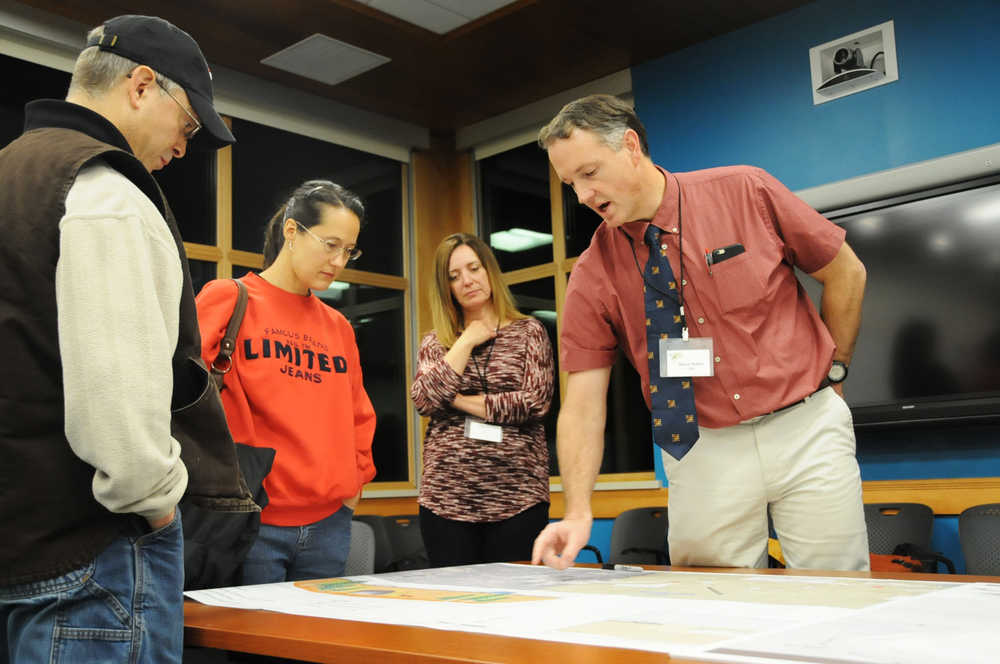The Sterling Highway through the Kenai National Wildlife Refuge may soon be a little more wildlife-friendly.
As a part of the resurfacing and road improvement project, the Alaska Department of Transportation & Public Facilities, the U.S. Fish and Wildlife Service and engineering consulting firm DOWL are incorporating projects to reduce wildlife collisions. The road has one of the highest wildlife-vehicle collision rates, and the engineers are working in some protective elements to help reduce it.
Most of the project is a pretty standard road-resurfacing project, but some stretches of it will include wildlife fencing to protect moose, according to DOWL project engineer Richard D. Pribyl.
Moose fencing is nothing new in Alaska — highways in the Mat-Su valley and in Anchorage have tried it to keep the animals off the roads. There is still a foot of space beneath the fence to let small animals go under normally to make them as permeable as possible. However, the project is trying something that is brand new: off-ramps for moose.
“Trying to figure out how to get moose out of the fencing should they end up on the road, there’s really no previous studies or projects that have really looked at the right way to get moose off the road,” Pribyl said. “The moose gets up to the top and hopefully jumps out of the road corridor, and the other way it looks like a wall, and hopefully doesn’t want to jump back in.”
If a moose happens to wander on the road and gets stuck between the sections of fencing, it can present a problem. Anchorage has tried moose gates, which theoretically allow the moose to pass through one way to get off the road, like a turnstile. However, they sometimes break, turning from a gate into a door, and require maintenance. The ramps are “like a ski jump” for moose, according to DOWL vice president Steve Noble, who also worked on the project.
“The jump-outs are looking at being about seven feet tall,” Noble said. “The gates do work, but the maintenance on them is a problem. It adds up. It’s easier if it doesn’t require that kind of maintenance.”
In addition to the fencing and jumps, the project will also include some wildlife underpasses that make it easier to moose and caribou to cross under the highway rather than on it. DOWL, which is based in Anchorage and has worked on several city plans and rural highway projects in Alaska, has been working with Fish and Wildlife for several years to develop the best plan for where to place the underpasses, Noble said.
There are several underpasses on the project, stretching from Skilak Lake Road near Mile 58 to Kenai Keys Road at Mile 79. One key underpass is near the East Fork Moose River, where the contractors will install a bridge with no pillars that allow moose and caribou to pass freely underneath.
Dr. John Morton, the supervisory biologist for the Kenai National Wildlife Refuge, said caribou and moose tend to shy away from passing through culverts to get across highways. The wide-open spaces beneath the highways should allow them to move more freely, he said.
“We didn’t want to put them under the four-lane sections because we wanted to avoid that tunnel effect,” Morton said. “Culverts are more meant for bears or small mammals. The caribou tend to shy away from them. These underpasses are meant for moose and caribou.”
The planners also included adjustments to some of the curves that lead to wildlife crashes. Morton said one of the curves near Moose River lead to moose collisions because drivers cannot see the moose crossing and don’t have time to stop.
In addition to the wildlife considerations, Noble said the project will improve some of the signage and pulloffs along the road as well, such as moving the parking lot for Lily Lake to the other side of the road and improving the parking lot at Skyline Trail. The parking lot at Skyline Trail will be paved and an underpass for pedestrians will be installed.
The road itself is gaining a little more width, too — the shoulders will be widened from three feet to eight feet on each side.
“For those of us that road bike, that will be spectacular,” Morton said.
The project is federally funded through a combination of funding sources and will cost approximately $75 million, depending on the bid of the contractor. Noble said the final plans for the project would be done in March.
Because the road is significantly busier in the summer, there will be no construction during the month of July, but the construction will likely begin in June and continue for several years, on and off, with breaks in the winter. Noble said long stretches with pilot cars are likely and occasionally closures. The project managers will try to accommodate traffic as much as possible, he said.
Reach Elizabeth Earl at elizabeth.earl@peninsulaclarion.com.

